Study the following information carefully and answer the questions below.
Eight students M, N, P, O, A, B, C and D participated in a IBPS PO Examination which took place in two phase having pre exam of 100 marks as 1st phase and mains exam of 200 marks as 2nd phase. They were sitting around a circular ring facing the centre. All eight students got different marks in pre exam i.e. 72, 50, 64, 81, 82, 61,59 and 87 but not necessarily in the same order. They also got different marks in mains examination i.e. 138, 122, 164, 168, 182, 150, 154 and 192 but not necessarily in the same order.
Note: The one who got highest marks in pre exam got the highest marks in the mains exam as well. M sits 3rd to the left of B. The one who got 138 marks in the mains examination is facing P. A got thrice the marks in mains examination what he got in the pre examination. The one who got the highest marks in the mains examination is sitting immediate right of N. Two students who got half the marks in their pre examination what they got in their mains exam are immediate neighbours. O sits 2nd to the left of N and is not facing B. The one who got the highest marks in the mains exam is neither M nor B. The one who got.150 marks in the mains exam faces C. The one who got 122 marks in the mains examination sits immediate right of O.B got 168 marks in the mains exam. The difference in the marks of P and M what they got in pre exam is 8. P got 5 marks more than N in the pre exam. The one who got 154 marks in the mains examination faces O. D got the highest marks in the pre exam.
If A is related to 192, and in the same way O is related to 182 then following the same pattern B is related to?
164
150
122
168
The correct Answer is:B
Step 1: From the given definite conditions: - M sits 3rd to the left of B. The one who got highest marks in the mains examination is sitting immediate right of N. O sits 2nd to the left of N and does not face B. The one who got highest marks in the mains exam is neither M nor B. The one who got highest marks in pre exam got the highest marks in the mains exam as well. D have . highest marks in the pre exam, so from this it is clear that D got 192 marks in the mains exam. So from the given statement above we can deduced that N does . not sit either immediate left or immediate right of M, so there are only two places where N can sit is 2nd to the left of M and immediate right of B. And in the same. way there are two places where I can sit as O sits 2nd to the left of N. Hence there are two possible cases.
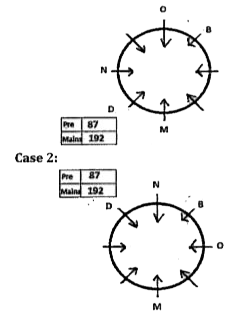
Step 2: It is given that, the one who got 122 marks in the mains examination sits immediate right of O. The one, who got 154 marks in the mains examination faces O. A got thrice the marks in mains examination what he got in the pre examination, So from these it is clear that A got 50 marks in Pre exam and 150 marks in the mains exam. But it is given that B has got 168 marks in the mains exam, and as in the 2nd case B has got 122 marks in the mains exam which can the 2nd case will be eliminated.
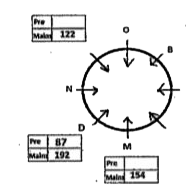
Step 3: Now it is given that, the one who got 138 marks in the mains examination is facing P. The one who got 150 marks in the mains exam faces C. So C faces A as A got 150 marks in the mains exam as mentioned in step 1 and there is only place where A can sit is immediate right of M. The one who got 138 marks in the mains examination is facing P, so P faces N. Two students who got half the marks in their pre examination what they got in their mains exam are immediate neighbours. So one of them is C as he got 122 marks in mains, and other student will be O, so O got 82 and 164 marks in the pre mains respectively.
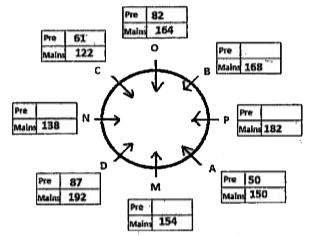
Step 4: As it is given that, the difference in the marks of P and M what they got in pre exam is 8. P got 5 marks more than N in the pre exam, so from these two statements we can deduce that P got 64 and N. got 59 marks and M got 72 marks in the pre exam, Hence we deduce the final result.
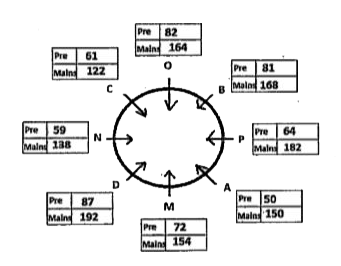
Similar Questions
प्रयोग के आधार पर एक धातु ऑक्साइड का सूत्र M0.98O पाया गया । यदि धातु M इस ऑक्साइड में M2+ और M3+ के रूप में विघमान हो तो धातु का जो प्रभाज M3+ के रूप में होगा, वह है :
View Solutionठोस AX में A+ आयन के चारो और X− आयन की व्यवस्था है, जैसा की चित्र में दर्शाया गया है (सही माप सूचक नहीं है) । यदि X− आयन की त्रिज्या 250 pm हो तो A+ आयन की त्रिज्या है :
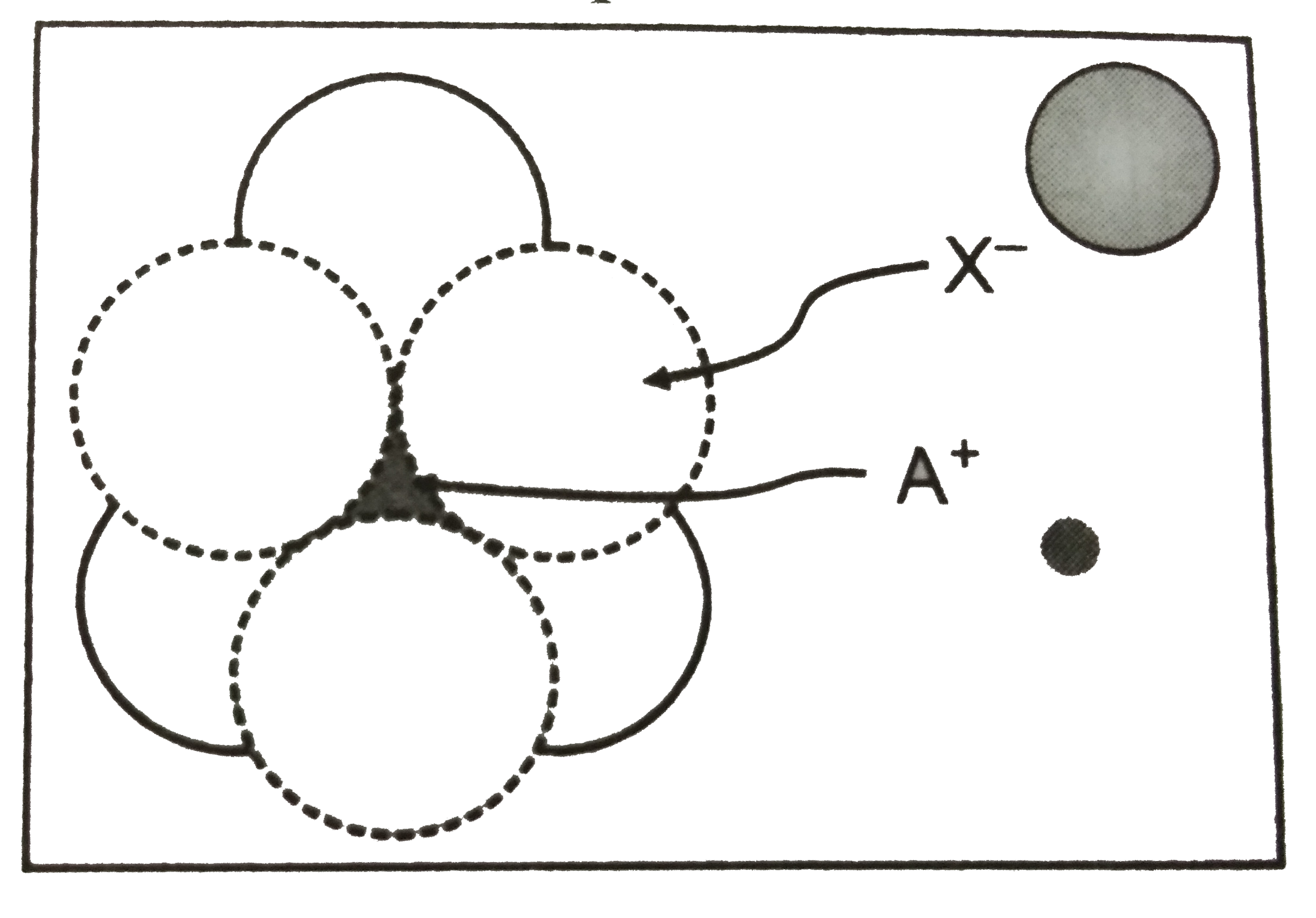
View Solutionपांच तत्व A, B, C, D व E के E∘ क्रमशः −1.36,+0.32,+1.36,−0.42 तथा −2.2.6 है उनको बढ़ती सक्रियता के क्रम में लिखो ।
View Solutionसमान चालकता सेल में लिए गए दो विलयनों A तथा B के प्रतिरोध क्रमशः 50 ओम तथा 100 ओम है । यदि A व B के सामान आयतन मिला दिए जाये तो सामान चालकता सेल में मिश्रण का प्रतिरोध क्या होगा ?
(मोल A व B को मिलाने पर वियोजन की मात्रा में कोई परिवर्तन नहीं होता है)
View Solutionयदि A और B दो घटनाएँ इस तरह से हों कि P(A)=13,P(B)=14,P(A∩B)=15 तो P(A/B)=
View Solutionनिम्नलिखित कथनों पर विचार करें :
कथन I : यदि A और B प्रतिदर्श समष्टि S के संगत दो घटनाएँ ऐसा है कि P(A)=0.2 और P((B)=0⋅8 तो A⋃B एक सुनिश्चित घटना है |
कथन I : यदि A और B परस्पर अपवर्ती हों तो P(A)+P(B)=1 इन कथनो में :
View Solutionयदि A तथा B दो स्वतंत्र घटनाएँ हों, तो सिद्ध करें कि P(A∪B)=1−P(A')P.(B')
View Solutionयदि acosθ+bsinθ=m तथा asinθ−bcosθ=n, तो सिद्ध करो कि a2+b2=m2+n2
View Solution